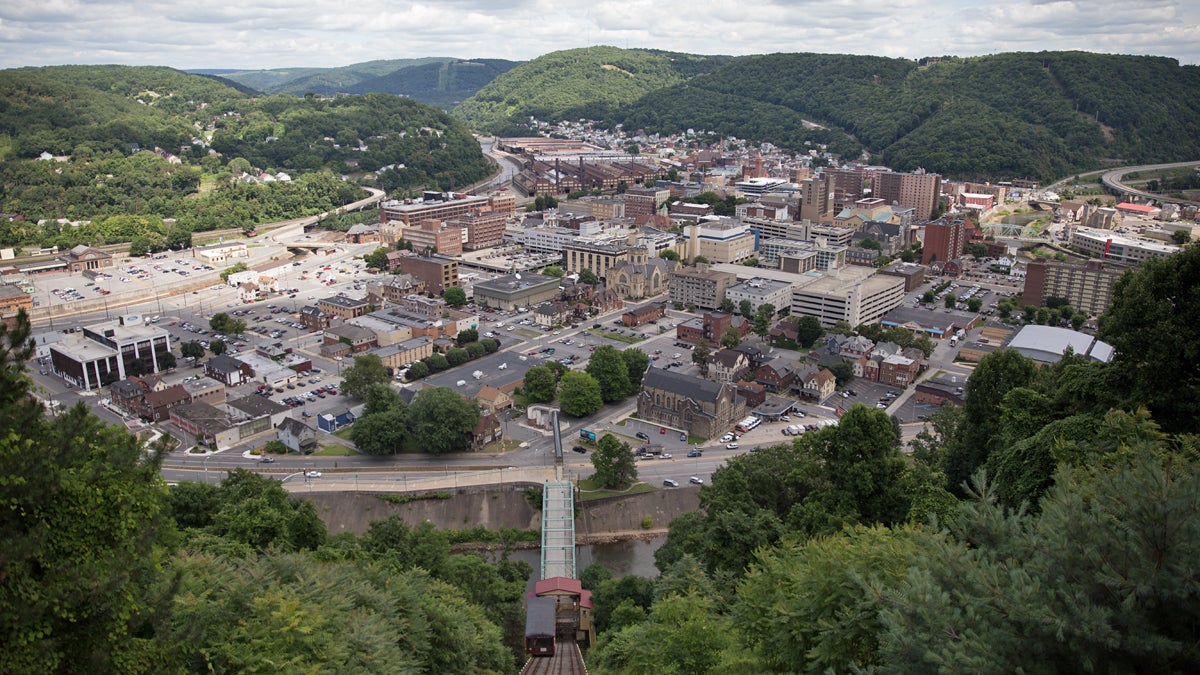Johnstown survey shows residents happy with arts initiatives but say crime and blight need more attention
Listen
A view of looking at downtown from Johnstown Inclined Plane. A recent survey by the Tribune-Democrat shows that residents are happy with arts initiatives but want to see more work on fighting crime and blight. (Lindsay Lazarski/WHYY)
A Johnstown newspaper evaluated progress on local issues. People are happy with arts initiatives but want to see more work on crime and blight.
Johnstown’s Tribune-Democrat, in Western Pennsylvania, recently conducted an online survey to evaluate progress on local issues. Johnstown is a shrinking industrial city with a nearly 9-percent unemployment rate, and one of the worst-funded pension systems in the state. But it’s also working to change things. Keystone Crossroads’ Irina Zhorov spoke with the paper’s editor, Chip Minemyer, about the results and what they could mean for other distressed communities.
Q: Could you start out by telling me what were people most satisfied with, least satisfied within the survey results?
A: Generally speaking, folks seemed to be satisfied with the attention that was being paid to arts and cultural opportunities in the region, which I think you see if anybody visits Johnstown, you’ll see a lot of those types of events and activities. And they were generally asking for more attention to the kinds of things you might see in a lot of places: that’s crime and drugs, job creation, and then blight, which is an issue in a lot of cities in Pennsylvania.
Q: So you actually sorted the results somewhat by age. Did you see big differences by these age groups?
A: Not big differences. It’s ironic, those top three elements, crime/drugs, job creation, and also blight were one, two and three in some order for all the age groups. It was interesting to see that some of the senior groups were more interested in seeing neighborhood development and work to improve neighborhoods. The younger folks were much more likely to say they wanted to see more of a focus on recreation as a tourism or economic driver, and it kind of makes sense when you step back and think about it, but that did fall along those lines.
Q: So crime and drugs, like you say, was one of the top concerns. Can you give a little bit of context of what’s going on in Johnstown for folks outside the region?
A: Absolutely. Crime and drugs was a focal point of some of our elections that just wrapped up. There’s been a drug task force in Johnstown for some time working, local police and local authorities working with the Attorney General’s office because it’s a major problem there. Cambria County, where Johnstown is located, matched Philadelphia County for the top overdose rate in Pennsylvania for the three years leading up to 2011. That’s a pretty scary statistic for a fairly rural area. So drugs is an issue. And we have a fairly high murder rate per capita, Cambria County and specifically the city of Johnstown. And that’s something that a lot of elected officials are dealing with and that certainly was reflected in the survey results.
Q: I know you’re still going through the data. What other things are you hoping to glean from it as you continue your analysis?
A: One of the things we were very curious about was, and this is in relation certainly to the question of drugs and crime, and that’s housing. And is there fairly strong availability of housing, especially middle-income housing? We asked that very specifically and people said they were satisfied with the availability of middle-income housing. As a matter of fact, real estate prices are very reasonable in the Johnstown area, so if you wanted to buy a home in the $100,000 range you could find a nice one. So I think the question then becomes things like public housing, and Section 8 housing, and the proliferation of those items in the city proper. And is that disproportionate to other areas of the county? And I think we got a little sense that people feel that that’s the case and maybe that could have a connection to some other areas such as job creation or crime. So we’re going to try to analyze this further, share it with elected officials, share it with economic development folks, say ‘here’s what we found, help us understand it, help us then communicate that outward.’
Q: Johnstown is one of many communities throughout Pennsylvania that is struggling in a lot of ways, whether it be crime, blight. Do you think there are lessons to be learned from this survey for some of those other communities?
A: We hope so. And one of the things we’d really like to look at is how does Johnstown compare to a similar-sized city in Pennsylvania or elsewhere in the Rust Belt so-called area of the United States. How do we compare in terms of people’s feelings about the issues and what they think matters? And in the long run I think we’ll be able to provide some interesting anecdotal and, you know, empirical data that folks can learn from and maybe use as a mirror to look at their own communities. We would like to see that happen.
WHYY is your source for fact-based, in-depth journalism and information. As a nonprofit organization, we rely on financial support from readers like you. Please give today.


